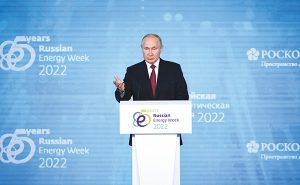Looking southeast from the Acropolis of Athens, the silhouette of the tanker Pskov barely stood up against the azure waters of the Aegean Sea. Inside her navy blue hull, almost 300 meters long, a hidden treasure: a shipment of liquefied natural gas.
Europe is thirsty for LNG after Russia shut down most of its pipeline gas sales to the continent, turning energy into a weapon in its war against Ukraine and its Western allies. Dozens of LNG carriers like the Pskov are docking into Europe now, hauling friendly gas supplies from overseas to keep the lights on and the houses heated this winter.
But the Pskov didn’t sail to Greece from a Western ally, like Qatar. No; ironically, she sailed from Russia itself. And not from any unremarkable Russian LNG port. Instead, it was the maiden shipment from a new terminal that Moscow is using to sell some of the very same gas that only a few weeks ago it shipped to Germany. The new facility is located alongside the infamous Portovaya turbine pumping station on the now defunct Nord Stream 1 pipeline.
The Pskov — and her unlikely origin — is part of a much wider, and ballooning, trade that’s receiving very little attention despite its political and economic significance. Almost under the radar, Russia is still selling hundreds of millions of dollars in LNG cargos, mostly to the same nations that have imposed sanctions against Moscow.
It’s a powerful weapon in its arsenal of energy armament. Although better known for its vast pipeline gas exports, Russia is also the world’s fourth-largest LNG shipper, only trailing Qatar, Australia and the US, and ahead of others like Malaysia and Nigeria.
The LNG sales aren’t nearly as big as the gas pipeline exports once were, but remain a source of money. “The Kremlin seems to have scored a geopolitical win by keeping revenues from global LNG sales intact,†argues Anne-Sophie Corbeau, a scholar at the Center on Global Energy Policy at Columbia University in New York.
Western countries have imposed sanctions on Russian oil, but they haven’t touched Russian gas. Thus, almost 80% of the LNG that the Kremlin has exported so far this year has gone to European and Asian nations that have imposed some sort of punitive measures against Vladimir Putin. They are paying market prices for the gas, and wiring the money directly to the Russian president’s supporters.
Putting China aside, Japan, France and Spain account for much of the purchases. On their current trajectory, Russian LNG sales will hit an annual record high in 2022, according to estimates based on tanker tracking data compiled by Bloomberg. Between January and September, shipments have averaged 2.78 million metric tons a month, compared with an average of 2.62 million for the full 2021 year and an average of 2.56 million in 2019, before the pandemic.
Spain, the world’s sixth-largest LNG buyer, has imported so far in 2022 more from Russia than any other year. Belgium is on track also to beat its own annual record. And France has bought about 6% more between January and September than during the whole of 2021.
The purchases show how Russia continues to exploit the Achilles heel of Europe and Northeast Asia: their dependency on natural gas. In Japan, that geopolitical tool is quietly working, with Tokyo taking a timid policy response against Russia. While top American and European energy companies such as Exxon Mobil Corp. and Shell Plc have left Russia, the Japanese government has counseled its domestic energy champions to stay. Japan has also insisted on excluding oil sales from a key Russian energy project from the G-7 oil price cap.
The LNG flows also show how Russia plays a cat-and-mouse game with its gas buyers in the West, shutting down some exports but keeping others open, cashing in record prices and using them as political and economic leverage. It’s part of an economic hybrid war that Putin mastered as a former KGB intelligence officer.
Should Europe continue buying Russian LNG? The moral case is obvious: no. And, above all, not from a Russian terminal built to bypass, if only partially, the now-defunct Nord Stream 1 pipeline.
The economic case is less clear cut: Next year, Europe would need all the LNG it can get hold of to rebuild, again, its gas stockpiles before a fresh heating season starts. As the International Monetary Fund put it earlier this week: “Winter 2022 will be challenging for Europe, but winter 2023 will likely be worse.†If the war in Ukraine continues, the continent needs the shipments. The benefit for Europe, avoiding a gas shortage next year, is probably larger than the benefit for Russia via extra revenue. From a pure economic view, it perhaps makes sense to buy from Russia.
But the geopolitical case is as simple as the moral one: As long as Europe buys Russian gas, whether via pipeline or LNG carrier like the Pskov, it would be at the mercy of Putin. It’s a seller’s market — and the seller, none other than the Russian president, can decide at his discretion when to close the valve or stop the ships.
—Bloomberg
Javier Blas is a Bloomberg Opinion columnist covering energy and commodities. A former reporter for Bloomberg News and commodities editor at the Financial Times, he is coauthor of “The World for Sale: Money, Power and the Traders Who Barter the Earth’s Resources.â€
 The Gulf Time Newspaper One of the finest business newspapers in the UAE brought to you by our professional writers and editors.
The Gulf Time Newspaper One of the finest business newspapers in the UAE brought to you by our professional writers and editors.

